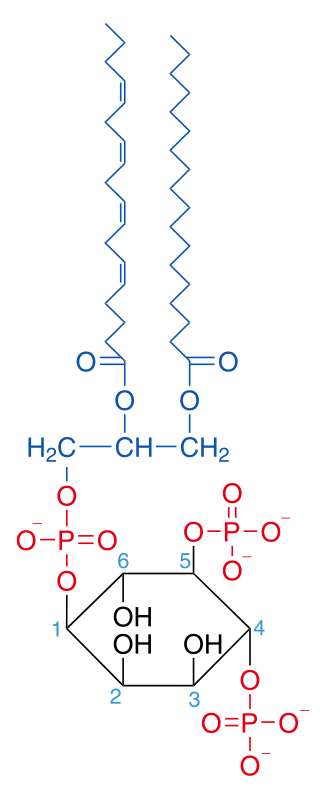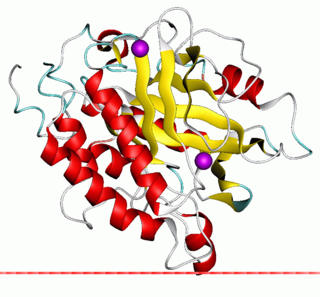
Phosphatidylinositol consists of a family of lipids made of a phosphate group, two fatty acid chains, and one inositol molecule. They represent a class of the phosphatidylglycerides. Typically phosphatidylinositols form a minor component on the cytosolic side of eukaryotic cell membranes. The phosphate group gives the molecules a negative charge at physiological pH.

Phosphatidylinositol (3,4,5)-trisphosphate (PtdIns(3,4,5)P3), abbreviated PIP3, is the product of the class I phosphoinositide 3-kinases' (PI 3-kinases) phosphorylation of phosphatidylinositol (4,5)-bisphosphate (PIP2). It is a phospholipid that resides on the plasma membrane.

Phosphatidylinositol 4,5-bisphosphate or PtdIns(4,5)P2, also known simply as PIP2 or PI(4,5)P2, is a minor phospholipid component of cell membranes. PtdIns(4,5)P2 is enriched at the plasma membrane where it is a substrate for a number of important signaling proteins. PIP2 also forms lipid clusters that sort proteins.

Phosphatidylinositol (3,4)-bisphosphate is a minor phospholipid component of cell membranes, yet an important second messenger. The generation of PtdIns(3,4)P2 at the plasma membrane activates a number of important cell signaling pathways.
Phosphatidylinositol phosphate kinases (PIPK) are kinases that phosphorylate the phosphoinositides PtdInsP and PtdInsP2 that are derivatives of phosphatidylinositol (PtdIns). It has been found that PtdIns is only phosphorylated on three (3,4,5) of its five hydroxyl groups, possibly because D-2 and D-6 hydroxyl groups cannot be phosphorylated because of steric hindrance. All 7 combinations of phosphorylated PtdIns have been found in animals, all except PtdIns(3,4,5)P3 have been found in plants.

The enzyme phosphatidylinositol diacylglycerol-lyase catalyzes the following reaction:
The enzyme inositol-1,4-bisphosphate 1-phosphatase (EC 3.1.3.57) catalyzes the reaction
The enzyme phosphatidylinositol-3,4,5-trisphosphate 3-phosphatase (EC 3.1.3.67) catalyzes the chemical reaction
The enzyme phosphatidylinositol-3,4-bisphosphate 4-phosphatase (EC 3.1.3.66) that catalyzes the reaction
The enzyme phosphatidylinositol-3-phosphatase (EC 3.1.3.64) catalyzes the reaction
The enzyme phosphoinositide 5-phosphatase (EC 3.1.3.36) catalyzes the reaction
In enzymology, 1-phosphatidylinositol-4-phosphate 5-kinase is an enzyme that catalyzes the chemical reaction
In enzymology, a 1-phosphatidylinositol-5-phosphate 4-kinase is an enzyme that catalyzes the chemical reaction
In enzymology, a phosphatidylinositol-4,5-bisphosphate 3-kinase is an enzyme that catalyzes the chemical reaction:

Type I inositol-3,4-bisphosphate 4-phosphatase is an enzyme that in humans is encoded by the INPP4A gene.
Bisphosphate may refer to:
Phosphatidylinositol 5-phosphate (PtdIns5P) is a phosphoinositide, one of the phosphorylated derivatives of phosphatidylinositol (PtdIns), that are well-established membrane-anchored regulatory molecules. Phosphoinositides participate in signaling events that control cytoskeletal dynamics, intracellular membrane trafficking, cell proliferation and many other cellular functions. Generally, phosphoinositides transduce signals by recruiting specific phosphoinositide-binding proteins to intracellular membranes.
72 kDa inositol polyphosphate 5-phosphatase, also known as phosphatidylinositol-4,5-bisphosphate 5-phosphatase or Pharbin, is an enzyme that in humans is encoded by the INPP5E gene.
Phosphatidylinositol-3,4,5-trisphosphate 5-phosphatase is an enzyme with systematic name 1-phosphatidyl-1D-myo-inositol-3,4,5-trisphosphate 5-phosphohydrolase, that has two isoforms: SHIP1 and SHIP2 (INPPL1).
Phosphatidylinositol-4-phosphate 5-kinases are a class of enzymes that phosphorylate phosphatidylinositol 4-phosphate. They perform this reaction on the fifth hydroxyl of the myo-inositol ring to form phosphatidylinositol 4,5-bisphosphate.






